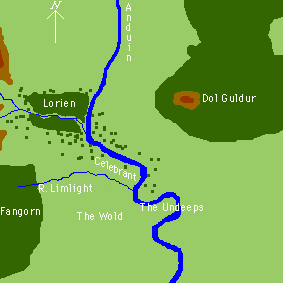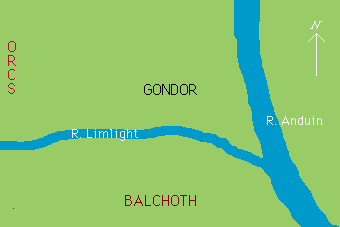Luke Ueda-Sarson's Fantasy Battle Scenarios for DBM:
The Field of Celebrant: 2510, Third Age


In the year 2510 of the the Third age, migrating Easterners crossed the river Anduin and invaded the grassy plains of Calenardhon, Gondor's most northerly province. Aided by Orcs from Hithaeglir (the Misty Mountains), the northern army of Gondor, led by the Steward, Cirion, was forced northwards out of Gondor across the Limlight river. When an Orcish army attacked it in the flank, all looked lost for Gondor, but the horsemen of Eotheod under Eorl the Young managed to arrive in the nick of time, taking the enemy in the rear. As gratitude for his rescue, Cirion granted the entire land of Calenardhon to Eorl, that afterwards became known as Rohan.

The battle is poorly documented, and thus following the course of the battle is somewhat difficult. (Page references within these notes refer to the Unwin paperback editions: The Return of the King (RotK) and Unfinished tales (UT), both from the 1983 reprints). This is the main descriptive passage, from RotK, p427:
"At last tidings came to Eorl of the need of Gondor, and late though it seemed, he set out with a great host of riders.
'Thus he came to the battle of the Field of Celebrant, for that was the name of the green land that lay between Silverlode and Limlight. There the northern army of Gondor was in peril. Defeated in the Wold and cut off from the south, it had been driven across the Limlight, and was suddenly assailed by the Orc-host that pressed it towards Anduin. All hope was lost when, unlooked for, the Riders came out of the North and broke upon the rear of the enemy. Then the fortunes of battle were reversed, and the enemy was driven with slaughter over the Limlight. Eorl led his men in pursuit, and so great was the fear that went before the horsemen of the North that the invaders of the Wold were also thrown into panic, and the riders hunted them over the plains of Calenardhon.'"
The battle site is in no doubt: the piece of land bounded by the rivers Anduin and Limlight at their confluence, since the army of Gondor was pushed over the Limlight, and hemmed in by the Orcs on one side, and the Anduin on the other.
The geographical relationship between these rivers, and the fords over the Anduin (the Undeeps) which Eorls' men had to cross are however murky. This is of vital importance. If the northern Undeep was above the confluence of the two rivers, Eorl attacks the Orcs in the rear, riding south; if it is to the south of the confluence, the riders attack the Easterlings in the rear, by riding south, then crossing the Anduin, then riding north again towards the Limlight.
There is confusion as to the exact location of the Undeeps. They are once referred to as lying on the westward loops of the Anduin: UT, p260: '...the two westward bends, known as the Noth and South Undeeps.' However, they are also once referred to as lying on or near the eastern loops: UT, p299; about the riders of the North, having passed DolGuldur: 'On their right the Anduin lay near, but they had almost passed its great eastward loop, and the Undeeps were in sight.'
In favour of the northern Undeep being above the confluence, it is said (UT, p260) that: 'In later days Gondor... often occupied the narrow land between Limlight and Anduin as part of its eastern defences, since the great loops of the Anduin... had many shallows and wide shoals over which a determined and well-equipped enemy could force a crossing'. It might seem pointless to guard Celebrant in this was if the crossing points were to the south. The battle description implies that the invaders of the Wold (the Easterlings) were ALSO thrown into panic, and pursued south, so it was the Orcs that were attacked first, and routed across the Limlight towrads the Esaterlings.
In favour of the northern Undeep being below the confluence, it is said (UT, p313) of Borondir, riding with Eorl '...was the first to cross the Limlight and cleave a path to the aid of Cirion. He at last fell on the Field of Celebrant defending his lord, Cirion.' This only makes sense if Eorl's men were moving NORTH over the Limlight to reach Cirion's position, which was north of the Limlight. How the enemy did not see Eorls men moving past them on the other side of the Anduin would then have to be explained (there were no trees there later in the Third age, FotR, p494-5).
However, If the 'Limlight' at UT, p313, is a mistake for 'Anduin' (and such georaphical mistskes have been made in describing the area before, see UT, p260), then the above paragraph fits in nicely: Eorl's men cross the Northern Undeep, that used to be guarded by some forts of Gondor (UT, p296), and moving south, hit the rear of the Orcs that were pressing the Gondorians eastwards towards the Anduin. The Orcs broke and fled south, with the riders pursuing them, and the riders moved to the assistance of Cirion, who had also been threatened by the Easterners across the Limlight.

The Anduin should be depicted as a river between 150 and 200p across (it was just possible to shoot across it it with bows: FotR, p502). It counts as a 'dangerous' river to cross - since while it could be crossed, it normally required pontoons or rafts to do so (UT, p260). The Limlight should be depicted as a river under 50p across, too small for fleets of boats to use, and its fordability is 'easy'. It was crossed by a retreating army, so can't be 'difficult', and as the only large stream for many a league, it is unlikely to warrant a rating of 'paltry', especially as the battle was in mid-April, when snow-melt from the Hithaeglir would be at its height. The weather is fine, with no game effects.
We are not told the strength of Cirion's forces, other than that they were diminished in numbers (UT, p296). Eorl's force is know (UT, p298): 'It is said that Eorl led forth some seven-thousand fully-armed riders and some hundreds of horsed archers.' The numbers of Orcs are also unknown, and the Balchoth are described (UT, p296) thus: 'They were only rudely armed, and had no great numbers of horses for riding, using horses mainly for draught, since they had many lare wains, as had the Wainriders (to whom they were no doubt akin) that assailed Gondor in the last days of the Kings. But what they lacked in gear of war they made up in numbers, so far as could be guessed.'
The forces are therefore pretty well much unknown, save the Eotheod. The Gondorians are defending, so must set up their largest command first. We shall count their baggage elements as already lost, since they have just been forced northwards over the Limlight, and are cut off from the south. This will also even things up for the attackers who will likely find themselves outclassed in DBM-combat terms. The Gondorians must set up in the centre of the board in an area defined (assuming a standard-sized DBM board is used in 15mm scale) as west of the Anduin, north of the Limlight, and at least 1200p from the northern and 1800p from the western table edges.
The Balchoth set up normally on the south side of the table, but restricted to the west of the Anduin (any naval elements they have may be deployed on the river). Their baggage must also be mobile (wagons), including that of their Orcish allies. The Orc command deploys last, on the eastern side of the board, north of the Limlight, upto 1200p in. The Gondorian allies, the Eotheod are not deployed on the table all. They are flank-marching, and will arrive on the northern half of the western table. They do not dice for arrival on the first or second bounds. They require 2 mobile bagage elements (pack horses with supplies).
At a scale of 1 figure representing about 150 men, the Eotheod will then comprise 2 elements of Irr LH (F), 2 of mobile Bg, and 15 Irr Kn (F), one which is the general's element (Eorl), for a total of 148 AP. If we let the Gondorians select 252 AP from the Gondor list, we will have an army totalling 400AP, albeit one that has already lost some Bg.
The invaders should come to 400 AP as well if we want a 'fair' fight. At least 100 AP of Orcs should be used, drawn from the Goblin list. The remainder should be Balchoth, drawn from the Easterlings list. They will move first.
The invaders will win if they demoralise the defenders without being demoralised themselves, OR, if they manage to destroy Cirion's element without becoming demoralised themselves. The defenders will win if both Cirion's and Eorl's elements survive, and the invaders are demoralised, OR if Cirion's element survives, the Eotheod are not demoralised, and the invaders are demoralised. Any other result is a draw (the invaders are repulsed, but the alliance between Gondor and the Eotheod will not be cemented).

This page last modified: 21 January, 2000